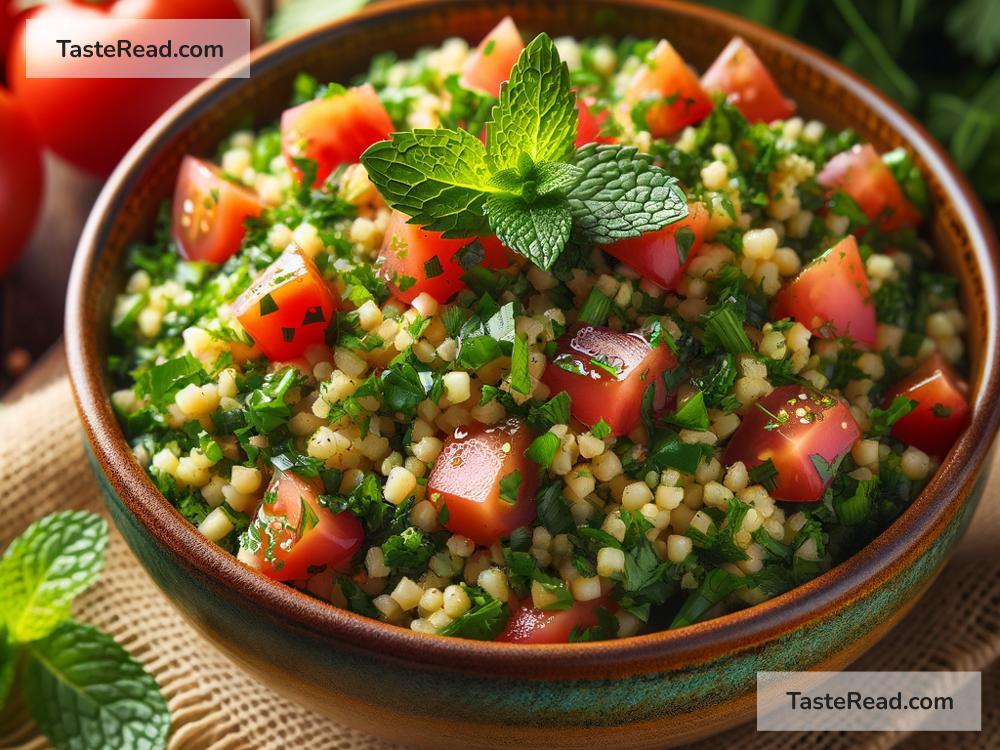The History of Lebanese Tabouleh
Lebanese tabouleh is one of the most famous salads in the world, known for its fresh flavors and nutritious ingredients. This beloved dish has a deep cultural connection to Lebanon, where it originated. Tabouleh is celebrated not only in the kitchens of Lebanon but also around the globe, reflecting the rich culinary tradition of the region.
Let’s take a closer look at the history of tabouleh, its ingredients, and why it’s so special.
What Is Tabouleh?
Tabouleh (also spelled tabbouleh or tabouli) is a healthy vegetarian salad made with parsley, bulgur wheat, tomatoes, mint, olive oil, lemon juice, and salt. In some variations, cucumbers or garlic may also be added. Its vibrant green color comes from the abundance of chopped parsley, which is the main ingredient. Unlike many salads, tabouleh is herb-heavy, with parsley and mint taking center stage instead of leafy greens like lettuce.
This salad is light, refreshing, and bursting with flavor, making it a perfect side dish or appetizer.
Where Did Tabouleh Come From?
Tabouleh has its roots in the Levant region, which includes modern-day Lebanon, Syria, Jordan, and Palestine. Its name comes from the Arabic word “taabil,” meaning “seasoning” or “spice,” which hints at its flavorful and aromatic nature.
Historians believe that tabouleh dates back over 1,000 years to the Middle Ages. Early versions of tabouleh were likely much simpler, as ingredients like bulgur wheat and olive oil were staples of Middle Eastern cuisine. These ingredients have been cultivated in the region for thousands of years, making them essential to local cooking.
During this time, parsley was highly valued. It wasn’t just used in cooking—in fact, parsley was believed to have medicinal properties and was often used in remedies. Later, parsley became a key ingredient in tabouleh, offering both flavor and nutrition.
Tabouleh and Lebanese Culture
Tabouleh became popular in Lebanon long before it spread to other parts of the world. For centuries, tabouleh was a traditional dish that united families and communities. It is an essential part of mezze, a collection of small dishes served at celebrations and gatherings. Mezze is central to Lebanese hospitality, offering guests a variety of flavors to enjoy.
Lebanon even celebrates its love for tabouleh through an annual festival! The “National Tabbouleh Day” is held every year in Lebanon, honoring the dish that represents the heart of its culinary heritage. During this festival, locals gather to prepare and enjoy huge quantities of tabouleh while sharing stories and traditions.
In some ways, tabouleh is more than just a salad—it’s a symbol of pride and identity for the Lebanese people. It showcases the country’s fresh ingredients, healthy cooking methods, and love for vibrant flavors.
How Is Tabouleh Traditionally Made?
Tabouleh is prepared by hand, and the process involves careful attention to detail. Parsley and mint are finely chopped, creating a soft, fluffy texture. To achieve the perfect balance of flavors, fresh tomatoes are diced and mixed into the herbs. Bulgur wheat, which is made from cracked wheat, is soaked until tender and added to the mixture.
The dressing is simple but essential: freshly squeezed lemon juice, high-quality olive oil, and a sprinkle of salt. These ingredients enhance the natural flavors of the parsley and tomatoes, creating a bright, zesty taste.
Tabouleh is traditionally served chilled or at room temperature. Although variations exist, Lebanese tabouleh always prioritizes fresh herbs over bulgur. In some Western versions, bulgur is used in larger quantities, but the original Lebanese recipe focuses on parsley as the highlight of the dish.
Nutritional Benefits of Tabouleh
Tabouleh is not only delicious but also packed with health benefits. It is rich in vitamins, minerals, and antioxidants. Parsley is known for its high vitamin C, vitamin K, and iron content. Bulgur provides fiber, which supports healthy digestion. And the olive oil and lemon juice in tabouleh are heart-healthy additions.
Because tabouleh is made with fresh, whole ingredients, it’s a nutritious option for both everyday meals and special occasions. It’s low in calories and perfect for vegetarians, vegans, and anyone looking for a healthy side dish.
Tabouleh Today
Over time, tabouleh has become a global dish. Thanks to Lebanese immigrants sharing their food traditions, tabouleh can now be found in Middle Eastern restaurants worldwide. It has also been embraced by home cooks who appreciate its simplicity and health benefits.
Today, tabouleh is enjoyed in many different ways—on its own, as a side with grilled meat or fish, or even scooped onto pita bread. Its versatility makes it a favorite for people of all ages and cultures.
Conclusion
Tabouleh is more than just a salad; it’s a piece of history, a symbol of Lebanese hospitality, and a celebration of fresh flavors. From its humble beginnings in the Middle Ages to its role as a global culinary ambassador for Lebanese cuisine, tabouleh has earned its place as one of the most cherished dishes in the world.
The next time you enjoy a plate of tabouleh, take a moment to appreciate the history and traditions behind every bite. It’s a dish that connects us to the past while reminding us of the beauty of simple, fresh ingredients.


